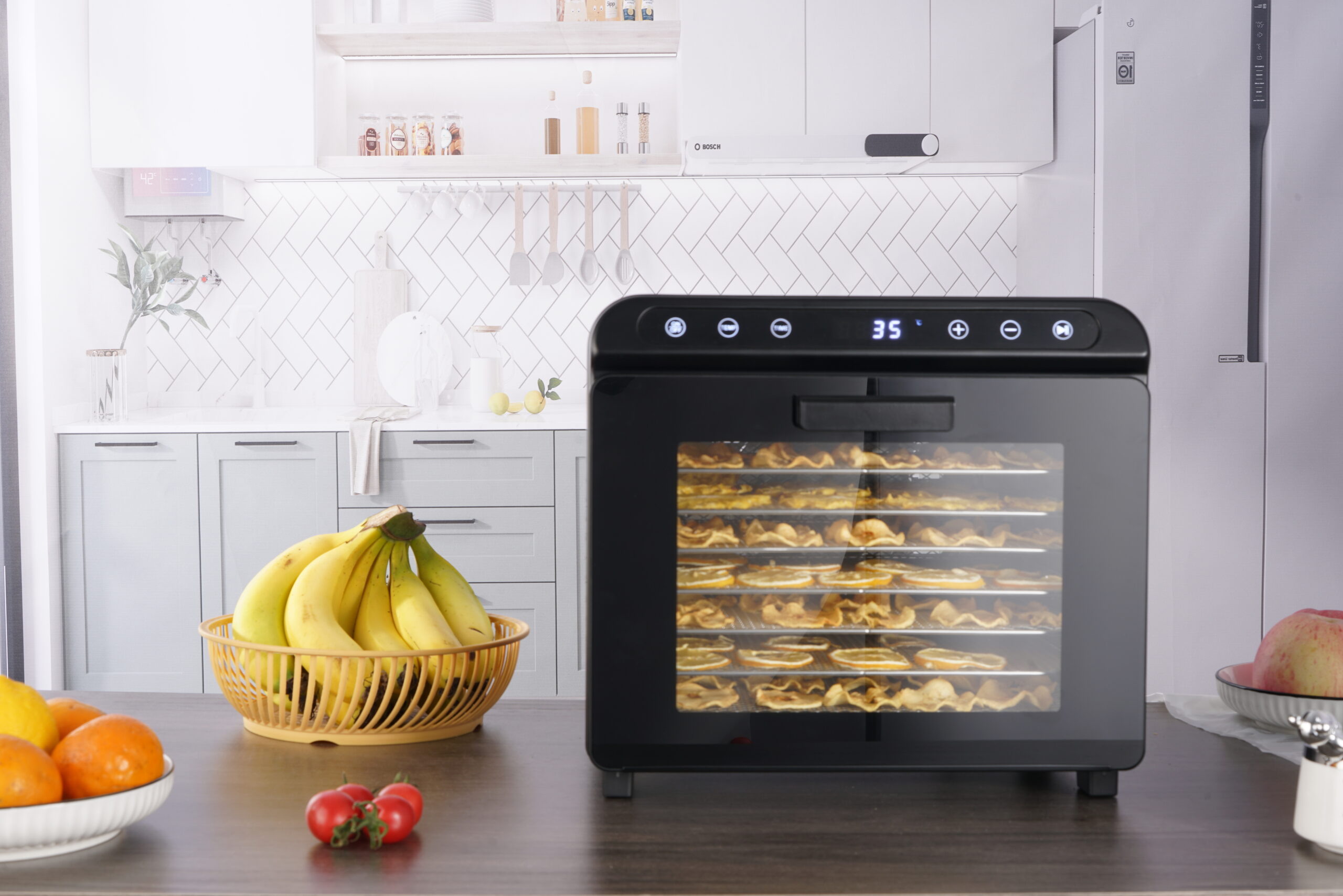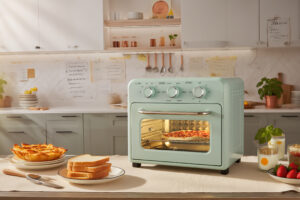Meta Title: Food Dehydrator Design for Maximum Drying Efficiency | Linden Smart
Meta Description: Discover how our food dehydrator’s innovative interior design maximizes drying efficiency. Learn about airflow, heat distribution, and customization at Linden Smart.
Permalink: /food-dehydrator-design-drying-efficiency
As the Sales Manager at Foshan Linden Intelligent Appliances Co., Ltd., I’ve seen firsthand how thoughtful design transforms everyday kitchen appliances into high-performing tools. Our food dehydrators—available in 12L, 16L, and 30L capacities—are engineered to deliver exceptional drying efficiency. This isn’t just about removing moisture from fruits, vegetables, or meats; it’s about doing so quickly, uniformly, and with minimal energy waste. In this article, I’ll walk you through how our interior design optimizes drying performance, making our dehydrators a top choice for kitchen appliance importers, distributors, and procurement officers worldwide.
Why Food Dehydrator Design Matters
Drying food is both an art and a science. A poorly designed dehydrator can lead to uneven drying, wasted energy, or spoiled food. At Linden Smart, we prioritize precision in every aspect of our design. Our goal? To ensure every tray dries consistently, whether you’re processing apples in North America or herbs in the Middle East.
Efficient design isn’t just about aesthetics—it directly impacts performance. According to research on food dehydration, optimal airflow and heat distribution can reduce drying time by up to 30%. That’s time and energy saved for your business. Our dehydrators are built to meet these high standards, combining advanced technology with practical features.
The Role of Interior Design in Efficiency
The interior of a food dehydrator is where the magic happens. It’s not just a box with trays—it’s a carefully engineered system. Our dehydrators feature strategic airflow patterns, precise heat control, and customizable tray layouts. These elements work together to maximize drying efficiency while preserving the quality of your food.
Let’s dive into the key design features that set our dehydrators apart.
Optimized Airflow for Uniform Drying
Airflow is the backbone of any high-performing food dehydrator. Without proper circulation, you risk uneven drying, which can lead to mold or inconsistent textures. Our dehydrators use a horizontal airflow system, which ensures hot air moves evenly across every tray.
How Horizontal Airflow Works
Unlike vertical airflow systems, which can create hot spots, our horizontal design pushes air from the back of the unit to the front. This creates a consistent stream that reaches every corner of the dehydrator. Each tray gets equal exposure to warm air, whether it’s at the top, middle, or bottom.
We’ve tested this system extensively in our factory’s three production lines. The result? Drying times are reduced by up to 25% compared to traditional vertical airflow models, based on internal testing. This efficiency is critical for businesses handling large-scale orders, where time is money.
Ventilation for Heat Consistency
Our dehydrators include strategically placed vents to regulate air pressure and prevent heat buildup. This design minimizes energy waste while maintaining a stable drying environment. For example, our 30L model features adjustable vents that let you fine-tune airflow based on the food type. Drying delicate herbs? Open the vents slightly for gentler circulation. Processing denser foods like meat? Increase airflow for faster results.
Precision Heat Distribution
Temperature control is critical in food dehydration. Too much heat can cook food instead of drying it, while too little can prolong the process and risk spoilage. Our dehydrators use advanced heating elements and smart thermostats to deliver precise, consistent heat.
Smart Thermostat Technology
Each of our models—12L, 16L, and 30L—comes equipped with a digital thermostat. This allows users to set exact temperatures, typically ranging from 35°C to 75°C, depending on the food. The thermostat maintains the set temperature within a ±2°C range, ensuring no part of the dehydrator overheats or underperforms.
This precision is vital for quality-conscious buyers, such as supermarket purchase managers or specialized kitchen appliance distributors. Consistent heat preserves the flavor, color, and nutrients of dried foods, meeting the high standards of your customers.
Even Heat Across Trays
Our heating elements are positioned to distribute heat evenly across all trays. We use a combination of radiant and convective heating to eliminate cold spots. This is particularly important for larger models like our 30L dehydrator, which can handle multiple trays at once. Whether you’re drying a single batch or maximizing capacity, every piece of food dries uniformly.
Customizable Tray Configurations
Flexibility is key in food dehydration. Different foods require different drying conditions, and our dehydrators are designed with this in mind. Our customizable tray configurations allow users to adapt the interior layout to suit specific needs.
Adjustable Tray Spacing
Our trays are designed with adjustable spacing, a feature that sets us apart from many competitors. For example, when drying bulky items like fruit slices, you can increase the space between trays to allow better airflow. For smaller items like herbs or spices, you can reduce the spacing to maximize capacity.
This adaptability is a game-changer for OEM and ODM clients who need versatile equipment for diverse product lines. Our 16L model, for instance, can accommodate up to 10 trays with adjustable heights, giving you the flexibility to scale production without sacrificing efficiency.
Durable, Food-Safe Materials
Our trays are made from BPA-free, food-grade stainless steel or high-quality plastic, depending on the model. These materials are not only safe but also easy to clean, reducing downtime between batches. The durability of our trays ensures they withstand the rigors of high-volume production, a must for B2B clients like kitchen appliance importers.
Energy Efficiency Through Smart Design
Energy efficiency is a top priority for us. In an industry where operational costs can add up, we’ve designed our dehydrators to minimize power consumption without compromising performance.
Insulated Interiors
Our dehydrators feature insulated interiors to trap heat and reduce energy loss. This design keeps the internal temperature stable, so the heating element doesn’t have to work overtime. According to energy efficiency studies, well-insulated appliances can reduce energy use by up to 20%. Our models are built to meet these standards, helping your business save on operational costs.
Low-Power Modes
For smaller batches, our dehydrators offer low-power modes that adjust heat and fan speed. This feature is ideal for businesses drying specialty products in smaller quantities, such as boutique food brands in Europe or Russia. It ensures you’re not wasting energy when full capacity isn’t needed.
Aesthetic and Functional Design Synergy
At Linden Smart, we believe design isn’t just about performance—it’s also about appeal. Our dehydrators combine sleek aesthetics with practical functionality, catering to buyers who value both form and function.
Modern and Traditional Styles
We offer a range of designs, from minimalist, modern looks to more traditional styles. This variety ensures our dehydrators fit seamlessly into any kitchen, whether it’s a commercial setup or a high-end retail product line. Warm color tones, like soft golds and earthy reds, are available to align with current market trends, as noted in design trend reports.
User-Friendly Interfaces
Our dehydrators feature intuitive digital controls, making them easy to operate even for first-time users. Clear displays and preset drying programs simplify the process, while advanced settings allow for customization. This balance of simplicity and sophistication appeals to procurement officers looking for reliable, user-friendly equipment.
Certifications and Quality Assurance
Quality is non-negotiable for us. Our dehydrators meet international standards, including CE, RoHS, and FDA certifications, ensuring compliance for export markets like North America and Europe. Each unit undergoes rigorous quality inspections at our factory to guarantee performance and safety.
Third-Party Testing
We collaborate with third-party testing agencies to validate our dehydrators’ efficiency and safety. This transparency builds trust with our B2B clients, from supermarket purchase managers to specialized distributors. Our commitment to quality ensures your customers receive products that meet their high standards.
Logistics and Customization for Global Markets
As a factory with a strong export focus, we understand the importance of logistics and customization. Our dehydrators are designed for easy shipping, with compact, stackable components that reduce freight costs. We also offer OEM and ODM services, allowing you to customize features like tray sizes, control panels, or branding.
Tailored Solutions for Your Market
Whether you’re in the Middle East or North America, we can tailor our dehydrators to meet local preferences. For example, we offer voltage adjustments for different regions and customizable accessories like mesh screens for fine herbs. These options make our products versatile for diverse markets.
Why Choose Linden Smart Dehydrators?
Our food dehydrators are more than just appliances—they’re solutions for businesses aiming to deliver high-quality dried foods. From optimized airflow to energy-efficient design, every element is crafted to maximize drying efficiency. As the Sales Manager, I take pride in knowing our products help our clients—whether they’re importers, distributors, or procurement officers—meet their goals.
Ready to elevate your product line with our food dehydrators? Visit www.lindensmart.com or connect with me at sales9@fslinden.com. Let’s discuss how our innovative designs can drive your business forward.
Word Count: 1,652




